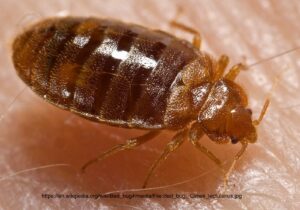
As outside temperatures drop and we move indoors and notice our indoor pests, our Extension questions shift to insects. As Halloween is coming soon, it’s the time of year I like to focus on the creepier bugs. Lets talk about the common bed bug, Cimex lectularius. Most people have heard of bed bugs, but they are not a very common household pest in Alaska and most Alaskans have never actually seen one. Perhaps our chilly winters, or cool summers, keep them confined to multi-family housing units and hotels. We also aggressively kill them when we find a population. Adults will not develop wings, so they rely on us to move them around, which is why eliminating a population helps control them. The insects themselves resemble a lygus bug nymph, but brown, and around ¼ inch. So, pointy head, flat body and short antenna without any of the thickening of the exoskeleton we’d see in shield bugs. Bed bugs can live for some time, around a year if need be. But in order for them to molt from one nymph to another requires a blood meal. So, if they never get that meal they can’t grow and will die. Which is why removing access to us, like using bed post moats, can help.
Sometimes it’s fun to think about abstract facts related to our pests. I was thinking about that blood meal and how many bed bugs would have to feed on me to do damage. Bed bugs can drink about six times their weight in a meal, and one bug weighs about 0.027 gram, which is 0.167 gram of blood per bug, per meal. Now blood makes up about 10% of our weight, and I weigh 165 lbs, or 74 kg. So, I have 7.4 kg of blood in me. We lose consciousness after losing about 40% of our blood, which is 2.96 kg for me. Thus, it would take 17,725 bed bug meals to get to that point. Bed bugs are also slow feeders and can take up to an hour to get a full meal. That’s a lot of bites, a lot of bugs, and a lot of time. I hope I’d notice 17,000 bugs in my bed long before I laid down for a nap.
Joey Slowik, IPM Technician, jaslowik@alaska.edu